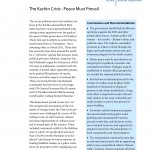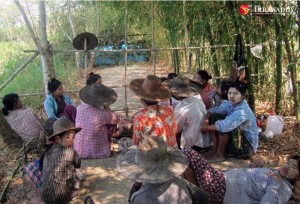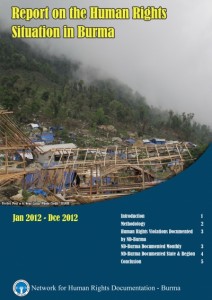Posts Tagged ‘Armed Conflict’ (233 found)
The Kachin Crisis: Peace Must Prevail
 The recent political unrest and military violence in the Kachin and northern Shan states has been on an unprecedented scale, raising serious questions over the goals of the quasi-civilian government of President Thein Sein and its ability to control the national armed forces (Tatmadaw). Since assuming office in March 2011, Thein Sein has received praise from around the world for a “reformist” agenda that has seen many political prisoners released, Aung San Suu Kyi’s National League for Democracy (NLD) win seats to parliament, ceasefires with the majority of armed ethnic opposition groups, and a gradual liberalisation of media, business and other aspects of national life. These are trends that the international community has been keen to encourage, with UN General-Secretary Ban Ki-moon and US President Barack Obama among world leaders visiting Burma/Myanmar […]
The recent political unrest and military violence in the Kachin and northern Shan states has been on an unprecedented scale, raising serious questions over the goals of the quasi-civilian government of President Thein Sein and its ability to control the national armed forces (Tatmadaw). Since assuming office in March 2011, Thein Sein has received praise from around the world for a “reformist” agenda that has seen many political prisoners released, Aung San Suu Kyi’s National League for Democracy (NLD) win seats to parliament, ceasefires with the majority of armed ethnic opposition groups, and a gradual liberalisation of media, business and other aspects of national life. These are trends that the international community has been keen to encourage, with UN General-Secretary Ban Ki-moon and US President Barack Obama among world leaders visiting Burma/Myanmar […]
Burma/Myanmar Delegation Expresses Support for the Special Rapporteur’s Report to the UN Human Rights Council
Geneva, Switzerland A panel discussion held on the sidelines of the 22nd Session of the United Nations Human Rights Council in Geneva yesterday looked at the recommendations made by Tomás Ojea Quintana, the Special Rapporteur on the situation of human rights in Burma/Myanmar, in his report to the Council and supported the need for further […]
• • •Burma’s Facade: An Update on Conflicts, Displacement & Human Rights Violations
This briefer, which covers the period from October 2012 to March 2013, includes the following developments:
- Regime authorities continue to commit serious human rights violations against Rohingya in Arakan State
- From December, the regime dramatically intensifies military offensives against the Kachin Independence Army
Declaration of Recognition and Support for the Kachin Independence Organization (KIO)/ Kachin Independence Army (KIA)
We, the undersigned Kachin communities and organizations worldwide, officially declare in solidarity that we adamantly recognize and support the objectives, goals and actions of the KIO/KIA government. We would like it to be absolutely clear that the KIO is the only legitimate […]
• • •Burma Still Requires the UN Human Rights Council’s Attention
 This week 22 organizations from Burma released a statement calling on the 22nd Session of the United Nations Human Rights Council to maintain its resolution on the situation of human rights in Burma under item 4 as “Human rights situations that require the Council’s attention” and to renew the full mandate of the Special Rapporteur Tomás Ojea Quintana. Serious human rights challenges that require the Council’s attention remain as the events of this week illustrate.
This week 22 organizations from Burma released a statement calling on the 22nd Session of the United Nations Human Rights Council to maintain its resolution on the situation of human rights in Burma under item 4 as “Human rights situations that require the Council’s attention” and to renew the full mandate of the Special Rapporteur Tomás Ojea Quintana. Serious human rights challenges that require the Council’s attention remain as the events of this week illustrate.
Border Security Forces in Arakan State allegedly raped 13 young Rohingya women. This highlights the serious remaining issues of the rampant culture of impunity for security forces and the Burma Army and the decades-long discrimination against the Rohingya organized and perpetuated by the government.
In Kachin State, despite ceasefire talks, fighting continued this week making more and more victims on the civilian side […]
• • •Civil Society Calls on UN Human Rights Council to Address Serious Human Rights Challenges in Burma/Myanmar
Civil society organizations from Burma/Myanmar are urging the United Nations Human Rights Council 22nd session to address the serious human rights violations that are challenging the country’s reform process. Today, 22 organizations released a statement […]
• • •Report on the Human Rights Situation (January – December 2012)
 The annual report of Network for Human Rights Documentation – Burma (ND-Burma) documented the human rights situation in Burma from December 2011-January 2013. The report provides information on human rights violations (HRVs) over this period and highlights pressing issues and trends taking place in Burma. The annual report covers human rights violations in 16 categories over all 14 states. Unsurprisingly, the highest incidences of abuse occurred in ethnic nationality areas that remain in open conflict with the Burma Army, the Tatmawdaw, or are the grounds for controversial development projects […]
The annual report of Network for Human Rights Documentation – Burma (ND-Burma) documented the human rights situation in Burma from December 2011-January 2013. The report provides information on human rights violations (HRVs) over this period and highlights pressing issues and trends taking place in Burma. The annual report covers human rights violations in 16 categories over all 14 states. Unsurprisingly, the highest incidences of abuse occurred in ethnic nationality areas that remain in open conflict with the Burma Army, the Tatmawdaw, or are the grounds for controversial development projects […]
Burma/Myanmar: Serious Human Rights Challenges Require the Continued Attention of the Human Rights Council
Civil society organizations from Burma/Myanmar urge the United Nations Human Rights Council (Council) to remain seized of the serious and ongoing human rights abuses occurring in Burma/Myanmar. The government has undertaken a series of noteworthy developments in the past two years which have been important and necessary steps towards democratic reform, however such developments remain […]
• • •World Must Act to End Burmese Military Aggression Against Kachin
A new report by the Kachin Women’s Association Thailand (KWAT) details widespread civilian casualties from recent Burma Army offensives in Kachin areas and urges international pressure to end military aggression against the Kachin people […]
• • •State Terror in the Kachin Hills
In late 2012, the Burma Army intensified military operations against strongholds of the Kachin Independence Army (KIA). This culminated in a massive offensive on the KIA headquarters at Laiza on the China-Burma border starting in mid-December […]
• • •








 All posts
All posts